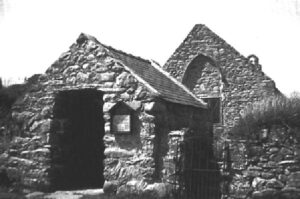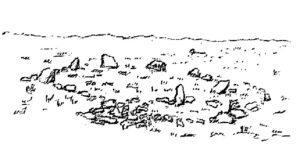Laurence Main finds an old spirit path in Wales
This did not begin with a thick pencil, drawing lines on a grubby, folded map. Perish the thought! My means of maintaining a modicum of sanity in this world is to escape to the hills and ancient trackways. Yes, old straight tracks. I didn’t make them straight. That’s just how they appear at times.
Anyway, I was enjoying myself taking a walk along the foothills of the Rhinogs overlooking the beautiful coastline of Meirionnydd (the southern half of Gwynedd in Wales). We still have an old-fashioned railway here, complete with convenient little halts which enable the pedestrian tourist to ramble between stations on a daily basis. The Cambrian Coast Line from Machynlleth to Pwllheli is also one of the most scenic in Britain. Come during the winter months and you can purchase tickets at bargain prices too!
The coastal zone of Meirionnydd is rich in ancient monuments and Paul Devereux has written about their correlation with fault lines and earth lights. My walk of 72 miles from Aberdyfi to Porthmadog took me past many places of interest and is now detailed in my guidebook A Meirionnydd Coast Walk (Gwasg Carreg Gwalch). One highlight of this route is the climb above Harlech to eventually reach the jagged silhouette which makes Bryn Cader Faner, the most beautiful of our Bronze Age cairn circles. Come on a clear day to enjoy the intoxicating views. I once led a party through perpetual thick mist in early August and was glad of my dowsing rods to lead me surely and precisely through what is an upland wilderness.
 Bryn CaderFaner
Bryn CaderFaner
With all the recent turmoil in the world of leyhunting, I have been reluctant to point my dowsing rods or do any of those things which might cause controversy. Sometimes things just slap you hard on the cheek, however, and you are forced to take notice. So it was that when I walked here the very earth seemed to nag me into action.
Now Mother Earth must like to show herself around Harlech. It can’t be mere chance (‘Oh, yes it can!’, I hear the sceptics cry) that led Robert Graves to relax here while temporarily ‘Away From All That’ in 1916. He only met his Nancy here, his first wife, who must have had a tiny influence on the man who was later to write The White Goddess. Harlech, too, is where Bran the Blessed was holding court when Matholwch arrived from Ireland to ask for his sister’s hand in marriage. Read all about Branwen, daughter of Llyr, in The Mabinogion. That marriage ended with Bran losing his head in Ireland. It was brought back to Harlech to be feasted for seven years and serenaded by the birds of Rhiannon. It was the sound of Rhiannon’s birds that my ears strained for as I toiled up the steep lane from Harlech. I really wasn’t looking for anything else. What is reported below comes from a sense of duty, not desire. A quiet life is preferable to dealing with critics.
Judge for yourself. The best way, of course, is to travel to Harlech (and by train — or may your tyres burst!) and exercise your legs. Until that glorious day, make do with Ordnance Survey Outdoor Leisure map 18, or Landranger 124. Bryn Cader Faner (Flag Chair Hill is one translation) is at SH648353. My hackles were raised at the crossroads and isolated chapel at SH591304. I did not want to know at that stage and it took me the five miles to Bryn Cader Faner to stir myself into responding to that ruddy alarm bell in my head.
Misery piled upon misery as I passed first one splendid example of a standing stone in a field on my right, then another on my left. Then I felt as if I was being led by a chain around my neck through the very gates of hell as I forked right off a lane onto a grassy track guarded by more stones, one of which definitely had its beady eye on me (see ill.).
More stones, and I had that sinking feeling inside me that I was walking between the remnants of a prehistoric stone avenue. At least it wasn’t allowed to follow a straight course. Moel Goedog (SH614325) had the decency to loom ahead, its contours forcing my track to curve around its northern side. This calming effect was spoilt by ancient earthworks crowning the summit of the hill, however, where the l.., sorry, alignment, led. My path even resumed this course on the other side of the said hill. Bogs did their best to nudge it slightly off the exact line, but my path was infuriatingly too close for comfort and lined by more evidence of those early vandals who obviously had so little respect for the countryside that they had to keep heaping stones in places.
I had even to endure the dispiriting sight of two rings; of stone, marked as cairn circles, either side of my track at SH610325. Later, I was to return to dream in the lower of these rings one June evening with a television crew. All three were beautiful young females. Two slept in one tent and recorded interesting dreams involving old fairy-men counting exact sums of money and exciting fairground rides. I had to make do with the most attractive of these ladies in my tent. We even felt forced to leave the door of our tent open to admire the sunset and the view towards Criccieth Castle. It’s a hard life.
Pairs of stone circles aren’t good for my constitution. They make me go all funny. In fact I sometimes can do with a nurse’s tender hand to calm me down. I blame a vivid dream on Cam Ingli involving the goddess Rhiannon dancing between the stones of a stone circle (although the initial overview was of a pair of circles) under a full moon. After much misting over, this concluded with the cupped hands of the goddess (now the words ‘holy’ and ‘grail’ have not been mentioned) in the earth and their fingers sticking out as the stones of a circle. Oh, and there had been this vision of a vortex of white light or spirit within these cupped hands and the impression that they belonged to Mother Earth which was being seeded by the starry sky. Straight lines of shining white light then carried this fertility through the land, as if streaming from a cauldron. Is it my vegan diet?
It was with great relief that I turned off this awesome line about one mile NE of Bryn Cader Faner, not before I’d disconcertingly overlooked Trawsfynydd nuclear power station. Now those nice people in grey suits and white coats who spend the taxpayers’ money wouldn’t build their safe and innocuous installations anywhere of interest to leyhunters, would they?
Itchy fingers can be a great nuisance. They lead you to do things like apply compasses to maps. The line I had walked corresponded to sunrise at the summer solstice (50o E of N) or, if you are of a more negative disposition, you could turn around and look towards sunset at the winter solstice (230o). You can’t escape the primary solar alignment. The path of the spirit is ley’d on the line. Winter evenings lead fools like me to gaze longingly at maps. I was forced to draw a line or two with ruler and pencil. Oh, horror! A line drawn from the crossroads and chapel at SH591304 to Bryn Cader Faner at SH648353 could be extended to a radio or TV mast at SH684383. This line continued to pass close to Bryn-saeth at SH716407. Lots of what serious researchers would claim to be significant sites (one way of dignifying a pile of old stones in the middle of nowhere) were very close to this line, which led down to the sea near the railway halt at Llandanwg. It is a fact that my leys are attracted to railway stations. The halt at Llwyngwril is at one end of my line to Dolgellau which passes the Llynnau Cregennen in route 4 of my book The Spirit Paths of Wales (Cicerone Press, £8.99; reviewed NE89). I do like trains.
 St Tanwg
St Tanwg
Precision is fine but the tantalising proximity to ley-markers invites the drawing of intimately close parallel or very finely diverging lines, with even the word ‘corridor’ springing to mind, would you Michael and Mary it? Leaving such complexities to Hamish [Miller – ed], I did draw another line slightly to the south of my first. I chose to start this from the old church by the sand dunes at Llandanwg. Dedicated to St Tanwg and housing ancient standing stones – one brought across the Irish Sea from the Wicklow Hills – this church is said to date from 435CE. It was also ‘a Chapell of Rest for corpses to be transported to yt fam’d Repository at Bardsey Island’ during the Middle Ages. There must have been a reason. Aiming for that summer solstice sunrise still, I took this past the old Roman fort of Tomen-y-mur to a TV transmitter at SH709392 and a point S of Bryn-saeth.

Lower cairn circle below Moel Goedog
I was, of course, gaily dowsing now with abandon to assorted females, so that they could swoon at the feel of my rods in their hands. The trouble is that my dowsing is so crude, involving sticks stuck in the ground and a hand-held Silva compass, that a degree or so has to be allowed for either side. It was fair to conclude, however, that a solar line terminating in the sea at Llandanwg led past Moel Goedog, Bryn Cader Faner and the vestige of a stone avenue (not to mention our friendly neighbourhood nuclear power station and transmission masts) to the vicinity of Bryn-saeth.
Bryn-saeth, which translates as ‘arrow hill’, belongs to a different country to the intensely rugged Rhinogs and to a different story in The Mabinogion. Many have been drawn to write their commentaries on it. Robert Graves even devoted chapter 17 of his White Goddess to ‘The Lion With The Steady Hand’. This is Lleu Llaw Gyffes and if you don’t know his story – the sort of romantic native British treasure that should be taught to every schoolchild but isn’t because it wasn’t written down in Latin, Greek or Hebrew – then get thee to a bookshop to buy The Mabinogion. Read The Glastonbury Zodiac by Mary Caine to realise that Lleu Llaw Gyffes is the British Light-god whose lance fertilises the land. He is Lugh of Lughnasadh, Leo and Lancelot. In summer he reigns supreme, only to be cuckolded like Arthur in the winter sign of Sagittarius, to die at the winter solstice but be resurrected as an Aquarian eagle. He can only be killed in special circumstances on the day he takes his annual bath. Were ritual sacrifices made then and buried under cairns of stones along our path? Regaining his human form, Lleu has his revenge, at the same spot.
Before killing Gronw, the lover of his wife Blodeuwedd, our solar hero allows his opponent to shield himself behind a stone. Lleu’s spear pierces the stone and, and this is the great thing, this very holed stone can still be seen at GR SH716405, near Bryn-saeth, at the NE end of our ley, spirit path, solar alignment or whatever you wish to call it.
That’s the trouble with taking a walk in the countryside, especially in Wales. It is alive with the eternal magical stories that can disturb those who just want to muggle along watching a box in the corner of their bigger box.
Published in NE90, Summer 2002, p12-15